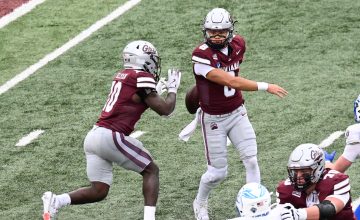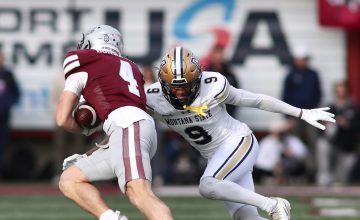There’s nothing like the wide eyes of a kid to give a description of how impressive something is.
As money continues to pour into Montana State University from all kinds of different private sources, the athletic programs haven’t been left out of the picture with the football program being the biggest benefactor. That hasn’t gone unnoticed to one longtime, albeit still young, Bozeman resident.
“I remember sneaking into games through a chain-link fence on the other side of the end zone,” said Montana State senior linebacker McCade O’Reilly, a Bozeman High graduate who has seen all the work being done around Bobcat Stadium since his grade school days, said. “(The stadium) wasn’t what it is now. It’s been awesome and it’s certainly been motivating and inspiring to know how many people care about this program.”
People a little newer to the area also have a good perspective on the benefits of such facility upgrades and construction.

“We no longer need to count on luck or what Mother Nature has in store for us,” MSU head coach Brent Vigen said of a new indoor practice facility in terms of getting good weather to practice in. “It goes without saying the impact it will have on recruiting. We recruit a lot of players from different climates. Having the ability to step on campus and see that indoor will make a significant impact on how they view this opportunity in front of them.”
Around $70 million has either directly or indirectly landed in or near Bobcat Stadium since 2010 with almost all of that coming from thousands of private donors. That year, MSU constructed a new south end zone grandstand that pushed the stadium’s seating capacity to 17,777 from around 12,500. The $11 million project not only increased what MSU could raise at the gate but also made the south end zone a tough place to be for visiting teams.
From there the Bobcats added stadium lights for night games and upgraded the scoreboard to the tune of about $1 million in 2011. In 2017 the playing surface was redone for about $650,000, before MSU completed its biggest project to that point in 2021 constructing the Bobcat Athletic Center in the north end zone. The $18 million project included locker rooms for football, a rehab center for all athletes, weight room, meeting rooms and offices.

That ‘biggest project’ designation didn’t last long as MSU is currently in the process of constructing an indoor practice facility, primarily for football and track and field that has a $26 million price tag. The football stadium just finished getting a new roughly 105’ X 35’ scoreboard and sound system for about $1 million to install and $3.5 million for the board itself. And the university is doing a massive reconstruction of the parking lots around the stadium with an estimated cost of around $13 million.
“The growth of Montana State football has been astronomical,” said senior tight end Ryan Lonergan, another Bozeman High graduate. “Going from the fieldhouse to this indoor facility has been awesome. All the resources that we have, we’re forever grateful for that.
“You’re going to be running and look up at the scoreboard and actually see something,” Lonergan said, regarding players being able to see themselves as a play is happening, instead of the grainy resolution that the old video board had.
The indoor practice facility will include a 300-meter track encompassing a 100-yard football field. The ceiling is 70’ feet at its peak and the distance from the football locker rooms to the front door is only about 150 yards with close to half of that distance under the west grandstand concourse. There are no stairs or steep slopes between the two buildings. The back door of the IPF is just a few feet from the outdoor track and field facility allowing those athletes a quick transition in the event of Montana’s ever-changing weather.

“I remember my freshman year and we were getting ready to play NDSU and we’re all walking from the fieldhouse with our heads like this,” senior safety Rylan Ortt from Missoula said while mimicking tilting his head into the wind. “It is just whipping wind across the parking lot. We only stayed out here for about 30 minutes before (the coaches) told us to go in.
“I want to thank everybody for raising money, building and organizing this indoor facility. I really think it’s going to be a huge step in both the football and track programs. I know that with where we want to go as a football team, being able to practice into late December and early January, and being able to move indoors when we need to is going to be huge. We have a lot of out-of-state recruits coming in and being able to see that will help them say that ‘this is a place I want to go.’ Even for us Montana boys we don’t mind getting out of the cold now and then.”
While the practice facility isn’t expected to be complete until early 2025, the area around and inside Bobcat Stadium has taken on a new look since last season. The parking lot is now entirely surfaced with asphalt and concrete with all the parking stalls marked. The drainage in the lot is enhanced, so tailgaters and, most importantly, students won’t have to deal with mud on rainy and snowy days. The surface will also allow for easier snow removal, something that has seemed inevitable at some point of each season.

The football team also has the option of using a now vacated indoor bubble by the fieldhouse as it waits for the IPF to be completed. That facility was being used during the construction of the new student exercise center. Now that construction is complete there, the equipment has been removed and an artificial grass surface has been installed.
Last season, MSU played a late Saturday night game on the road against Sacramento State. The Bobcats returned home for a short week of practice only to find iced over fields at both their grass and stadium surfaces. Practices were cut short every day leading up to their next game at Idaho and they stumbled out of the gate not scoring in the first half and needing over one-and-a-half quarters to get a first down in a 24-21 loss to the Vandals.
The Bobcats continue to prep for their August 24 season-opener against the New Mexico Lobos in Albuquerque.














